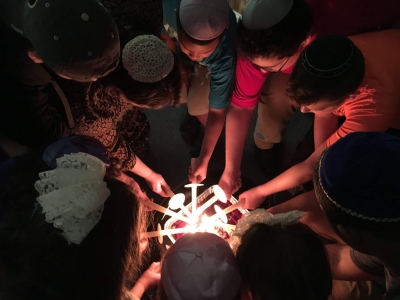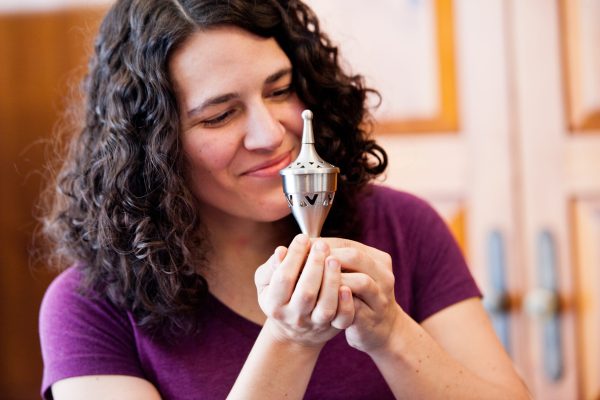Background
Every Sunday morning at the congregational school where I serve as Education Director, students and staff begin our school day by saying farewell to Shabbat through a havdalah ceremony. Expanding havdalah to bid farewell to the school year was a natural extension of this practice.
Havdalah, which means “separation,” is a multi-sensory, participatory ceremony that marks the transition from the Holy (kodesh) to the ordinary (hol). It includes four blessings: one over a cup of wine/grape juice, one over a box of sweet-smelling spices, one over a three-or-more-wicked havdalah candle, and one final one over havdalah itself. As each item is mentioned, at least one person interacts with that item. Someone sips the wine or juice; the spicebox is passed among the group so all can smell its contents; participants gather around the candle to observe the shadows it casts on their hands and fingernails. After the final blessing, the candle is doused in the wine, making a loud sizzling sound. The sizzle completes the transition from Shabbat time to ordinary time.
In this Havdalah Gedolah (Great Havdalah) ritual, the two sets of time being separated are the school year and the summer (or other timeframes appropriate to your group). The havdalah “candle” here has as many wicks as there are participants in the ritual.
Because most participants will be holding a candle with both hands, they will be unable to also hold prayerbooks or other objects. This ritual therefore works best if all or most of the group knows the havdalah blessings by heart. One or more members of the group (a teacher, counselor, or other adult) should stay outside the main circle to read the blessings and manipulate objects as needed.
You will need:
– a large baking dish or similar container
– a shelf, stepstool, or other item to raise the height of the baking dish. I used a second baking dish, turned upside down.
– a shallow, broad, liquid-proof tub to catch any spills. I used a large durable plastic tub; a kiddie pool would also work.
– long taper candles for all members of your group, except those who will be outside the main circle
– drip protectors for candles. You can buy pre-made ones or make your own from cardboard or paper cups.
– matches or a lighter
– at least one havdalah spicebox filled with sweet spices. Use more spiceboxes for larger groups.
– a kiddush cup
– enough grape juice to fill the baking dish and have some leftover for the kiddush cup. I found two 96 oz. bottles of juice to be more than sufficient. (You can also use wine, but wine in large quantities can be expensive!)
– a copy of your preferred version of havdalah blessings, in a prayerbook or on a sheet of paper
The Ritual:
Havdalah Gedolah should be the very last action of the year. Complete all other year-end tasks (cleaning out cubbies, giving out report cards, etc.) before assembling for Havdalah Gadolah.
To prepare for the ritual, place the tub on the floor in a large, empty space. Place the stepstool or other height-raising object in the tub, and then the baking dish on top of the stepstool. Fill the baking dish with grape juice. Pour grape juice into the kiddush cup. Place a drip protector on each taper candle.
Dim the lights to render your space as dark as possible. Gather participants in a loose circle surrounding the tub, and give each participant a candle. As mentioned above, one or more teacher or counselor should remain outside the circle to read blessings and manipulate objects.
Determine who among the students or campers has been a member of the group for the longest period of time (graduating seniors, for example). Light these individuals’ candles first. All others’ candles are to be lit from these first candles; have the senior student(s) walk around the circle to do so.
Instruct students to hold their candles with both hands, and at a slightly downward angle to help prevent excessive wax dripping.
When all candles are lit, have everyone begin to chant the havdalah blessings. My school uses the Reconstructionist version of these blessings as found in Kol Haneshemah: Shabbat Vehagim (Reconstructionist Press, 1994), but other groups will use other versions. Whoever is outside the circle can read the blessings from a prayerbook or sheet of paper.
After the blessing over the grape juice, a teacher outside the circle should take a sip from the kiddush cup. After the blessing over the havdalah spices, the teacher(s) outside the circle (more than one for a large group) should walk around the circle with the spicebox(es), holding the spices up to each participant’s nose to be smelled. No special action should be taken for the blessing over the candle flame.
You may want to modify the final havdalah blessing, changing the closing wording from hamavdil beyn kodesh lehol (who separates the Holy from the ordinary) to, for example, hamavdil beyn sha’nat ha’limmudim lekayitz (who separates the school year from the summer).
After chanting this final blessing, everyone should step forward, tightening the circle around the dish of grape juice. Next, all participants in the circle should extend their candles so that all flames meet in the center, forming one combined flame.
Together, all participants should lower their bodies—and correspondingly, their candles —until the central flame is just above the grape juice dish.
Take a moment to savor the intensity of this abundant, vivid flame, and the way it represents the learning, community, and spirit that has blazed among the group during the time they have shared.
Finally, participants should lower their candles in unison—and in silence—to immerse the flame in the dish of grape juice. (Have someone count down, in English or Hebrew, to help participants maintain a uniform pace.) Listen for the very loud sizzle as one set of time transitions to another.












